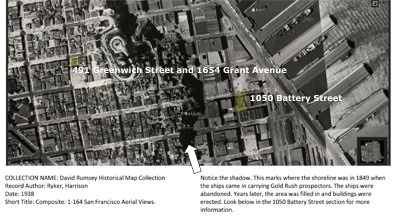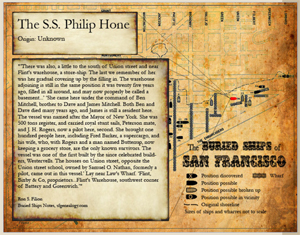business
Locations
491 Greenwich Street | 439 Greenwich Street
506 Washington Street | 441 Washington Street | 170 Pacific Avenue
1050 Battery Street
491 Greenwich Street | Map
1901-1978
Intersection of Dupont Street and Greenwich Street
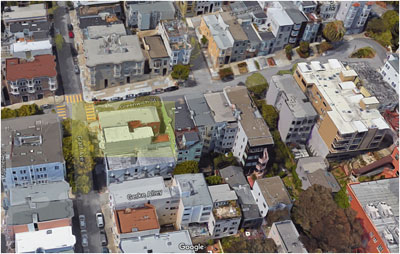
Sanborn Fire Insurance Map | 1899/1900
San Francisco Block Book | 1901
Sanborn Fire Insurance Map | 1905
San Francisco Block Book | 1909
Purchased from John G. Druhe | 2 Feb 1901
Druhe owned a grocery store at this location.
Although the Traversos owned 491 Greenwich, many of the listings in the San Francisco business directory indicate the grocery/liquor business was operated at 439 Greenwich Street. The phone number was DAvis 641.
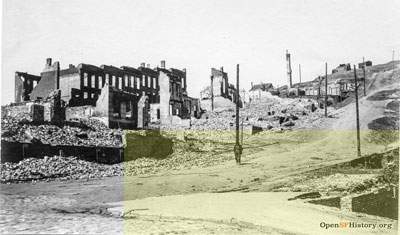
Grant Avenue (formerly Dupont Street) and Greenwich Street 1906
Highlighted area is 491 Greenwich Street
OpenSFHistory | wnp27.0413.jpg
By 1905, there were no more listings for the grocery business in the Crocker-Langley business directories. Following the 1906 devastation, Vittorio applied for and received a license to sell alcohol (San Francisco Call, Volume 50, Number 61, 31 July 1906) and in 1907 Vittorio was listing a liquor store at 439 Greenwich. It is believed that the "liquor store" was actually the Torriglia Saloon.
On 7 Aug 1908, Vittorio purchased from John E. and William J. O'Rourke the lot to the west of 491 Greenwich Street. The address was 1654 Dupont Street. This purchase doubled the size of the Traverso property. (Clipping - last entry) Notice in the photo below the building to the right of 491 Greenwich. This is 1654 Dupont. Research is still pending about when the building was sold. Vittorio and the family moved into this building and worked the businesses housed at 491 Greenwich.
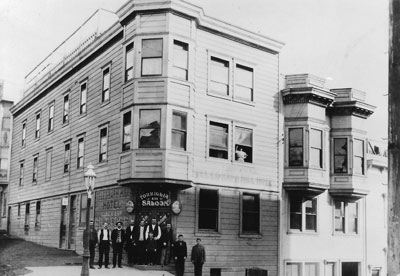
Traverso Archives
In the picture above, the sign over the door reads: Torriglia Saloon. On the side of the building is painted: Telegraph Hill Hotel. This is a speculation that following the fire which destroyed the building including a grocery, Vittorio rebuilt the first floor as quickly as possible to include housing for the family and a saloon in the front to generate income to complete the upper two floors which would officially become a boarding house by 1910. The boarders are indicated in the 1910 U.S. Census. All the boarders with the exception of Luisa Marcelliero were men and all were Italians.
Telegraph Hill Hotel | Established 1910
They charged $30 per month for room and board. The saloon remained at the front; however, the sign above the door was changed.
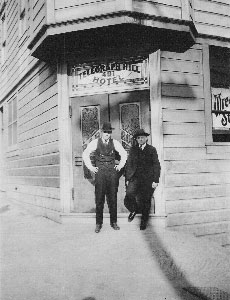
Traverso Archives
Reestablishing Ownership
after Quake and FireSan Francisco City Hall was destroyed by the 1906 earthquake and fire. All records were lost. By 1908, the Traversos were helping to recreate lost deeds by establishing proof of ownership through the Superior Court. The first Decree Establishing and Quieting Title occurred on 23 January 1908 by Vittorio for 491 Greenwich Street.
On 17 November 1909, Vic received a judgment reestablishing the ownership of 1654 Dupont Street.
Note: Vittorio had title insurance (15 March 1913 and 13 May 1924) for property in the area of Grant Avenue and Lombard Street near Child Street. It is believed that this insurance was issued in response to the McEnerney Act. Read the 1906 article. (San Francisco Call, Volume 100, Number 68, 7 August 1906) For further investigation read from the Land titles and burnt record acts. The McEnerney act of 1906, ... California.
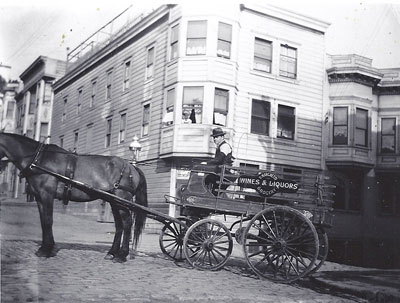
Traverso Archives
A check register used by Vittorio is a part of the Traverso Archives. It includes a record of checks written from 31 August 1911 through 28 September 1912. Many of the withdrawls were made to Builders Supply Depot on 8th (maybe 8th Street on the south side of Market Street). He probably was still working on the rebuilding of the boarding house following the 1906 quake and fire.
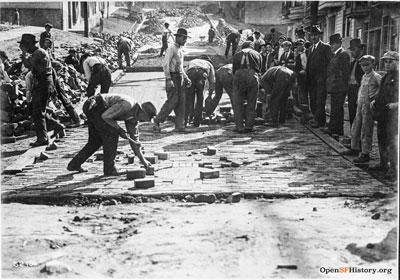
Greenwich between Kearny & Grant looking east towards Telegraph Hill | 1918
OpenSFHistory | wnp36.01822.jpg
1920 U. S. Census includes 12 lodgers at the Telegraph Hill Hotel.
There was a full bocce ball court in the basement. The base was crushed abalone shell.
Not sure when the court was installed; however, it was there when the building sold in 1978.
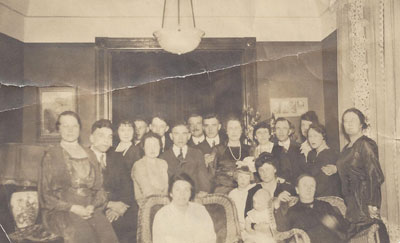
Traverso Archives | Lodgers | Undated Photo
San Francisco instituted rent control in 1979. Twelve months prior to the Rent Ordinance of 1979 went into effect, the family decided it was time to sell 491 Greenwich which by this time housed apartment renters. Older buildings, such as this one, needed constant maintenance which often cost more than the collected rents. It was a practice for Jack, who was the manager of the building, to raise rents appropriately to meet the expenses. As soon as it became evident that the family would hold a liability rather than an asset, the building was sold.
Dupont Street was named for Captain Samuel F. Du Pont, who commanded the flagship Congress and afterwards the sloop-of-war Cyane. This street was the original "Calle de la Fundacion" of William A. Richardson and ran from about the line of California Street north-northwest. It was later swung into line with the other streets by Jasper O' Farrell. The street acquired an unsavory reputation by becoming the residence of an undesirable class of citizens. These disreputable residents were removed and following the earthquake and fire of 1906, the name of the street was changed to Grant Avenue.
The Oldest Street in San Francisco
In 1861, a new city ordinance called for the numbering of San Francisco's streets. Read the story.
According to the San Francisco Municipal Reports of 1871-72, there was a fire hydrant at the sw corner of Greenwich and Dupont.
Saving Telegraph Hill 1890-1918 - "George and Harry Gray dug at the east face of Telegraph Hill for about 20 years, mostly with the blessing of City Hall. They persevered through bankruptcies, barrages of rocks from irate Irish and Italian hill dwellers who sometimes saw their small homes tumbling down the cliffside after a quarry explosion."
December 27, 1900 | The San Francisco Call from San Francisco, California · Page 12 | Grocery Entered by Burglars | J. G. Druhe. grocer, 439 Greenwich Street, reported to the police yesterday that his store had been entered Tuesday night by burglars. They broke open the cash drawer and stole $10 besides taking away a lot of tobacco and other articles.
From the report of (Fire) Chief McCluskey, District No. 1: DUPONT & GREENWICH STREETS: 32,000 gallons; April 20th, The fire was then sweeping over Telegraph Hill rendering it impossible to reach the only unused cistern at Dupont and Greenwich Sts. Read more about the cisterns used and unused during the quake and fire of 1906.
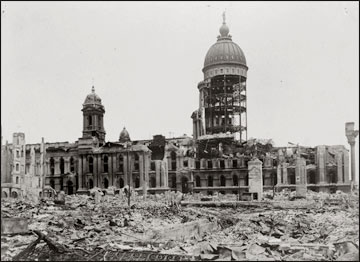
San Francisco City Hall and the Hall of Records were destroyed. The documents proving the marriage of Vittorio and Luisa, the births of Bill and Jack, and land purchase records were lost.
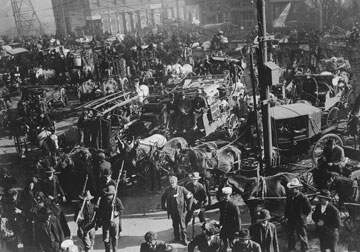
Refugees Leaving the City
"Long ago, at the northeast corner of Grant and Gerke was a restaurant and a rooming house. The house at the end of the alley, No. 6, was built in 1884 and later became the property of Frank Bacigalupi. (Bacigalupi is the maiden name of Luisa Traverso, the mother of the three Traverso brothers.) When the house next door was for sale, Bacigalupi withdrew $2,000 in gold coin from his savings on April 17, 1906, to buy the building the next day. Of course the sale was not consummated; instead Bacigalupi joined the other refugees trudging out to the presidio. Guarding his suitcase full of gold, he was able to act quickly after the fire had been subdued. Instead of buying the property next door, he used his money to purchase 18-inch redwood boards which the army had bought to help rebuild the ravaged city. Brushing aside the still-warm embers and using the old foundations, Bacigalupi built two houses on his lot within a week. These structures, one fronting on Greenwich and the other at 6 Gerke Alley, were among the first post-fire buildings on Telegraph Hill. San Francisco's Telegraph Hill by David F. Myrick, page 127.
North Beach: Little Italy "After the 1906 earthquake and fire, Germans, Russians, Eastern Europeans moved out permanently while Italian migration into the neighborhood continued. The Italian influence on North Beach peaked between the two World Wars when over 60,000 of its residents claimed Italian ancestry and five Italian language newspapers circulated the neighborhood. By the 1920s, North Beach was predominantly Italian and known as "Little Italy."
Read the ArticleTelegraph Hill Historic District "Telegraph Hill is one of the most famous hills in the world, as well-known as Sugar Loaf in Rio de Janeiro, and a visual landmark to sailors entering the Bay since its European discovery by Capt. Juan Manuel de Ayala in the San Carlos on August 5, 1775."
Read the ArticleNO. 1010 ORIGINAL SITE OF THE THIRD BAPTIST CHURCH (FORMERLY THE FIRST COLORED BAPTIST CHURCH) - In August 1852, Abraham Brown, Thomas Bundy, Thomas Davenport, Willie Denton, Harry Fields, George Lewis, Fielding Spotts, and Eliza and William Davis organized the church in the Davis home. The congregation purchased the old First Baptist Church and moved it to this location in 1854. The church is now located at 1399 McAllister Street.
Location of plaque: Corner Grant Avenue and Greenwich Street, San Francisco (1654 Dupont Street)
According to David F. Myrick (San Francisco's Telegraph Hill, Page 197, 1972), "Mike's Grocery is at the corner of Grant, and in the same building during the 1930s was a lodging house, more grandly listed in the directory as the Telegraph Hill Hotel, with the entrance at 485 Greenwich Street."
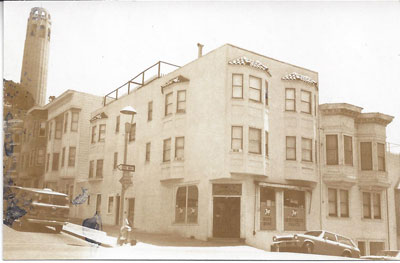
Traverso Archives | Mike's Market 1961
Current business: The Telegraph Hill Gallery
506 Washington Street | Map
1922-1924
Location is between Hotaling Place and Sansome Street (Building is gone)
This location is around the corner from the famous Monkey Block of Montgomery Street.
Across the street from current location of the Transamerica Pyramid
John Stratman was a dealer of melainotypes, prints, books, newspapers and military goods; active in San Francisco c.1864-c.1872. By 1869, his store was listed at 506 Washington Street, advertising him as a “bookseller,” and by 1875 he was a liquor salesman in San Francisco.
441 Washington Street | Map
1924-1931
Between Sansome and Battery Streets | Building is gone
Across from what is now the US Citizenship & Immigration Services
(There is some confusion about the location of the business during these years. Letters addressed to the company use 445 Washington Street. The San Francisco Guides use 441 and 443 Washington Street. Perhaps there was expansion during this period.)
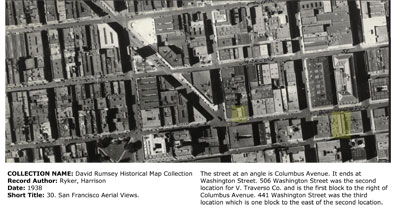
Currently, Il Massimo Del Panino Restaurant<
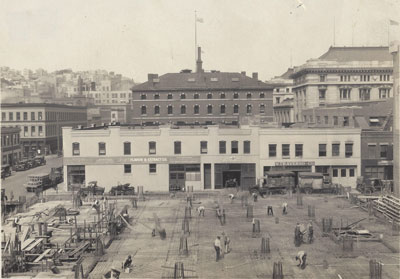
Traverso Archives | circa 1931
The narrow street at the back of V. Traverso Co. is Merchant Street. The crew at this building site is working on plumbing installation. The car on the left at the back of the building looks like a 1931 Ford. The two back to back trucks behind the warehouse are Mack mid- to late-twenties.
170 Pacific Street | Map
1931-1944
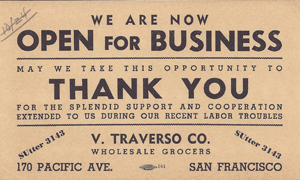
Traverso Archives
Now part of the Golden Gateway Commons -"The Golden Gateway Project was an ambitious Redevelopment Agency effort started in 1958 to clear the crowded produce district from 17 city blocks northwest of the Ferry Building in order to allow a mixed-use expansion of The City’s financial district." DOCOMOMO/NOCA
Grocers Getting Ready for War | 25 September 1936
Two years after the West Coast Waterfront Strike of 1934, V. Traverso Co. announces that it is prepared to supply its 178 member stores learning from the previous experience.
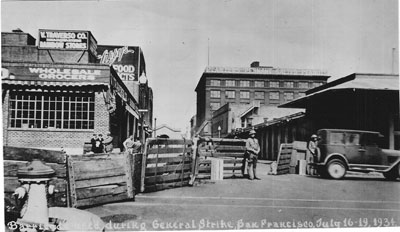
Traverso Archives | 16-19 July 1934
The 1934 West Coast Waterfront Strike lasted eighty-three days, triggered by sailors and a four-day general strike in San Francisco, and led to the unionization of all of the West Coast ports of the United States.
Produce Market 1920's to mid 1950's
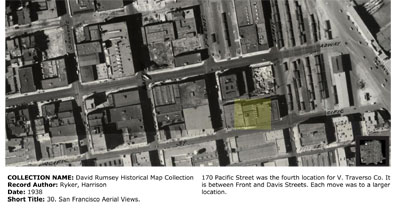
Farmer's Market 1943 at Duboce and Market Streets
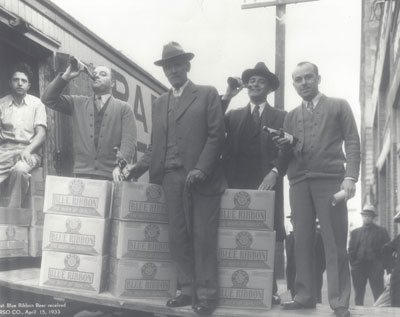
Traverso Archives | 15 April 1933
Vittorio, the acting manager of the business, is standing in front of the cases of beer. Vic and Bill are tasting and Jack is on the right.
New Beer’s Eve, 7 April 1933 | “I recommend…the passage of legislation…to legalize the manufacture and sale of beer.” - President Franklin D. Roosevelt
Prohibition-era Booze Recipe Traverso Archives
800 Grocery Clerks Reject Union's Negotiations
Oakland Tribune | 23 September 1938
Rail cars at the back of 170 Pacific tagged by union sympathizers.
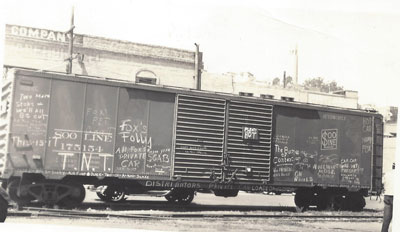
Traverso Archives
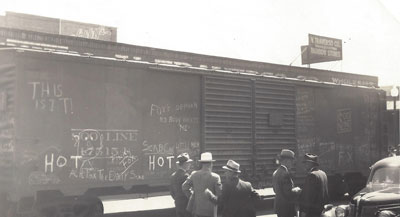
Traverso Archives | Jack on far right
1050 Battery Street | Map
1944-1964
Between Union and Green Streets
50 VARA Block No. 15
Purchased from B. F. Porter Estate, a corporation (deed)
28 February 1944
Building continues to be owned by the Traverso family within the Traverso Brothers LLC
It is listed in the National Register of Historic Places in San Francisco as the Armour and Company Building. It was designed by Henry Geilfuss & Son and was built in 1907 in an Italianate style and was used as a meat packing plant and smokehouse by Armour and Company until 1934.
Draft National Registration Form (PDF)
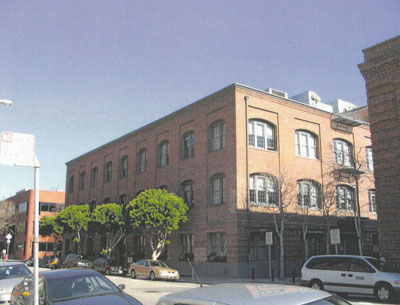
Traverso Archives
Building Overview
Built in 1907
Three-story building with full basement
Footprint of structure is 9,000 square feet for a gross building area of 36,000 square feet
Useable area is estimated at 32,054 square feet
Masonry brick construction with timber support columns and roof support
Three levels at or above street level are for office use and include an elevator, two interior stairways, and six restrooms
Basement is combination of office/conference room with a full commercial "teaching" kitchen, lounge area and three restrooms
The occupants of 1050 Battery Street between 1934 and 1944 are unknown, but the property remained in the Sesnon/Porter family until 1944, when Victor, Jr., John A., and William F. Traverso bought the property. In keeping with the history of the northeast waterfront and 1050 Battery Street, the Traverso brothers used the building as a wholesale grocery warehouse. V. Traverso Co. remained at 1050 Battery Street until the company dissolved in 1964. The dissolution of Traverso and Rainbow Stores coincides with the demise of the northeast waterfront as a light industrial warehouse district.
BATTERY street was so named because of the battery (a fortified emplacement for heavy guns) erected by Lieutenant Misroon on Clark's Point. Clark's Point was between Cunningham's Wharf and the Broadway Wharf. Now, east of Battery Street is fill. Visit this map of buried wharfs and ships.This area of San Francisco is known as the Northern Waterfront. Here is history about the seawall.
It may be that the building is located on top of the Philip Hone, a ship that arrived in San Francisco at the time of the Gold Rush. Scroll down on this page about Seaports and Captians to get more information about the storeship.
In 1848, just before gold seekers from around the world descended upon the tiny settlement of San Francisco, the site of 1050 Battery Street was beneath the San Francisco Bay. That year, William Squire Clark arrived in the newly annexed California territory to pursue business ventures, but noticed an absence of wharves where cargo could be unloaded and warehouses where supplies could be stored. Thus, Clark built a small redwood warehouse and a stone pier from rocks he quarried from Telegraph Hill. Clark located his warehouse and pier just to the east of Telegraph Hill, where he could take advantage of the bay’s deep waters and the protection that the hill provided from westerly winds. After building his own warehouse and pier, Clark set about promoting the northeast waterfront’s warehousing facilities, thereby creating San Francisco’s first warehouse district. The world soon rushed in and followed Clark’s lead. By 1851, quarried rock from Telegraph Hill, undoubtedly combined with abandoned ships, had filled the bay nearly to today’s Front Street, resulting in flat lands – including the land where 1050 Battery Street stands – for building and development. Warehouses dominated the new landscape.
Robert Courland, the Old North Waterfront: The History and Rebirth of a San Francisco Neighborhood (San Francisco, 2004)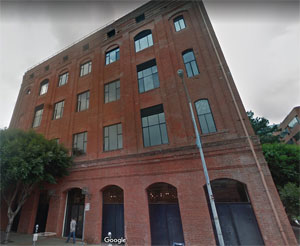
National Ice and Cold Storage Co., built 1914, across street
